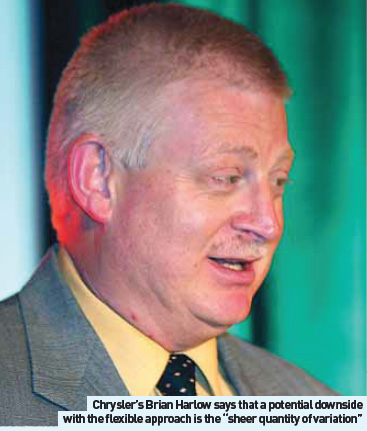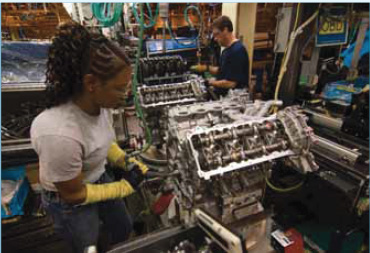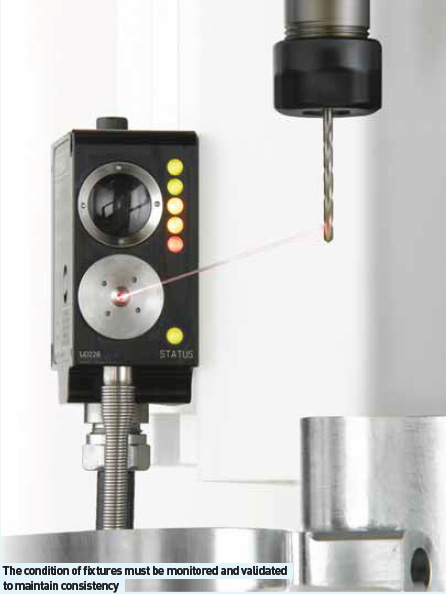
You’re only as good as the last great production run you had, and in an increasingly competitive market, having the right machines and processes to do the right job is critical
With its reputation for high overall equipment efficiency (OEE), there is no better manufacturer to talk about the demands of modern automotive machining than Nissan. Within the group, one facility shines as a leader in OEE, being even more productive than the company’s Sunderland, UK facility or even Japanese plants. That site is Nissan’s North American engine facility in Decherd, Tennessee, USA. The 1.2 million square foot powertrain assembly plant has an annual capacity of 950,000 engines and 300,000 transaxles, as well as producing castings for both crankshafts and engine blocks. It produces all the engines for the complete line of Nissan and Infiniti vehicles manufactured in the US, including 2.5 litre 4-cylinder, 3.5 litre 6-cylinder, 4.0 litre 6-cylinder and a 5.6 litre 8-cylinder versions. One of the engines it produces – the 3.5 litre V6 VQ – has been named in Ward’s Communications’s ‘Ten Best Engines’ list for ten consecutive years.

“We have a number of new models, but with our flexible transfer lines (FTLs) and CNCs, it is not a major change for us because we have the flexibility to make those changes without a lot of shut down or modification,” says Gary Edwards, Manager at the Decherd site. “The latest trend for Nissan has been the flexible machining centres.” The initial capital outlay to set up a flexible transfer line is somewhat more than a traditional line, but that extra cost is soon recovered. “Over the past few years we have had numerous design changes on our engines, but with the flexible transfer machines, we can go in and just make program and tool changes. You don’t really have a whole lot of hard machine changes; most of it is just tools, grips and programs.
“We made the initial investment to buy the FTLs, but they have paid off based on that, because we haven’t had to go in and tear out any equipment,” Edwards tells AMS. There is still a place for traditional CNC machines at Decherd, but with the growth of the FTLs, they are primarily used to make the dies for the foundry.
Investment saves money in the long run
A gantry system serves the plant’s three FTLs. Using the crankshaft line as example, Edwards says, “Once you have placed that crankshaft from the overhead transfer gantry into the machine centre, the flexibility of the gantry system itself gives you the opportunity to do what you want with it. It can flow through like a traditional transfer line or we can place it anywhere that we want to with an overhead gantry system.
 “Again that was an extra expense in the beginning but since then we have gone from casting cranks to forged cranks, and added crankshafts. We haven’t had to do anything other than to modify programs to our overhead gantry system,” he adds.
“Again that was an extra expense in the beginning but since then we have gone from casting cranks to forged cranks, and added crankshafts. We haven’t had to do anything other than to modify programs to our overhead gantry system,” he adds.
The gantry systems, Edwards explains, are something that have become more common at Nissan plants across the world over the past decade. “With the early machining lines, we were still using transfer systems and transfer rails for the machining of the crankshafts. I know that in the UK Nissan plant they use the gantry system for heads and blocks, and some of the new systems that they have in the French plants I have visited.”
The flexibility that the system supplies is not just on the one line, but lines can be switched quickly too. “For example, we have three flexible transfer lines. If one line goes down, the other two lines are still running. They all do the same processes, but they have the flexibility to be reprogrammed if needed, but we don’t run a straight system, we run a flexible transfer system. This means if you are running three lines, you can shut down two of them, modify one line and continue production on the third line,” Edwards explains.
 A major $35 million investment at Nissan’s Decherd, Tennessee factory has started to pay dividends as the automotive OEM offi cially launched cylinder block casting production at its Powertrain Assembly Plant. The expansion is the plant’s fourth addition in ten years of production.
A major $35 million investment at Nissan’s Decherd, Tennessee factory has started to pay dividends as the automotive OEM offi cially launched cylinder block casting production at its Powertrain Assembly Plant. The expansion is the plant’s fourth addition in ten years of production.
“Opening the cylinder block casting operation can be counted as another success for the Decherd team,” comments Bill Krueger, Nissan Senior Vice-President of Manufacturing, Purchasing, Supply Chain Management. “This operation represents a vote of confi dence in the team’s ability to thrive in the increasingly competitive global marketplace.” At full capacity, the 51,000-square foot facility will have an annual production of 192,000 cylinder block for engines manufactured in Decherd and destined for Nissan vehicles built at the company’s assembly plants in Smyrna, Tennessee and Canton, Mississippi.
Initially, the operation will produce cylinder block castings for the 3.5 litre V6 VQ found in the Altima and Maxima sedans. Later in 2008, additional capacity will be used to produce the 4.0 litre V6 engine for the Pathfi nder and Xterra SUV, and Frontier pickup. Previously, castings were shipped in from Nissan’s Iwaki plant in Japan. Moving the cylinder block casting operation on site has the dual benefit of reducing inventory and transport costs. The new operation also complements the plant’s just-intime manufacturing practises.
“In a challenging business climate, recognising and acting on every possible synergy will prove to strengthen Nissan’s position in the global automotive industry,” Krueger explains. “Moving cylinder block casting onsite at Decherd is a key component in creating a lasting impact on this plant’s ability to compete in an increasingly difficult market.”
The new casting facility is located next to the engine machining plant. Featuring two 2,500 ton, US$3.3m high-pressure die cast presses, the casting facility requires about 50 staff. Total square footage for the Decherd plant is now over one million square feet.
It features a state-of-the-art chip recycling system, which melts down process aluminium chips from the machining operation to be used in the casting process. This reduces overall aluminium costs while improving waste streams.
Forging flexible machining
The main change that Edwards has dealt with this year is the introduction of in-house forging – something that although a huge challenge, has delivered significant advantages. “We started our own forging in Decherd and that helped us a lot in our crankshaft machining because it gives us flexibility. We can look closely at what we are doing, change things and reduce our costs overall in machining. We can leave less material on the forging to machine off than we did before because we now have control over the entire process.” Edwards tells AMS he has two primary challenges, maintaining the high OEE targets that they have set themselves and dealing with an ageing plant. “We have a lot of maintenance systems here with our TPM and PM systems we put in that allows us to maintain that equipment like new. Once the machine starts to wear, the challenge is keeping up with the TPM and the preventive maintenance programmes. “With OEE, we were the benchmark for machining and we still are on several lines. When we started these lines in 2002, machining was about 70 per cent OEE, then we set our target at 80 per cent, and now the industry standard is 80 per cent. We are now actually running as high as 95 per cent on some of our super OEE lines,” he adds. “In every fiscal year, we increase our OEE target. As long as the equipment is here, we expect to meet our OEE targets. If they can’t, we’ll have them modified, refurbished or replaced.”
The cost of flexibility
But as Brian Harlow, General Manager of Transmission Casting and Machining Manufacturing at Chrysler explains, that flexibility comes with its own cost to the manufacturing process. “A potential downside with the flexible approach is the shear quantity of variation, something that is an anathema to those driving for standardised processes. With that many different machines and all the adaptor plates, you have a lot of variation potential.
“You are into the realms of hundreds of different fixtures and all those have to be the same. Over time, though, they wear differently, or become damaged in some way; there has to be a sophisticated process for validation of those, as well as a measurement system that you use statistically to maintain the process,” Harlow tells AMS. “You have to be able to sample an adequate quantity off each machine, off each pallet and that can add a lot of complexity. So the measurement system becomes the most complex and difficult system to manage in the entire machining process.” It is not only the automotive OEMs that have to keep pace with modern machine tool technology. If anything, the Tier One suppliers have surpassed their OEM customers. One such supplier has invested more than $6 million (£3m) in three automated machining lines based on gantry robot-fed twin-pallet machining centres to produce steering knuckles. King Automotive Systems, part of the Amtek group, has made the investment at its Coventry factory for producing two different types of steering knuckle for passenger cars. Based on 11 robotically-loaded horizontal machining centres, the tailor-made turnkey lines were designed and built by NCMT, sole UK agent for the Japanese machining centre manufacturer Okuma. A second Okuma line, comprising three machining centres, has since been installed to machine knuckles for the new Land Rover Freelander 2, while a third line, with seven Okuma machining centres, is devoted to machining knuckles for the BMW MINI.
It’s a grind for crankshafts
Czech company Strojírny Poldi has an excellent worldwide reputation as a manufacturer of crankshafts. The superfinishing operations on these high-tolerance engine components call for the tightest concentricity tolerances. A new CBN crankshaft grinder from Naxos-Union provides precision in the μm range.
Located near Prague, the company has a history of playing an important role in the world market for tool steels, structural steels and specialty steels and also for the machining of these materials, but a particular focus for more than a century has been crankshafts. The company is headed by managing director Vladimir Trubaz and currently employs more than 600 staff, 300 of whom work in the crankshaft division, with the remainder in the rolls and tools divisions. The crankshaft division produces parts with a maximum length of 2,000mm, primarily for use in truck engines and other large applications. Annual output at Kladno amounts to approximately 55,000 crankshafts, going to customers such as Agco and Volvo.
The company’s newest investment is a PMD 320 S Crankshaft Grinder from Naxos-Union, part of the EMAG Group. This pin-chasing grinder features two independent wheel heads and is designed to finish grind all main and pin bearings on the crankshaft in a single set up. The conventional plunge-cut grinding and pin chasing processes are complemented by a diagonal grinding process that ensures the radii and shoulders of the various bearings can be ground with flexibility and without being limited by the width of the grinding wheel.
 To increase flexibility and simplify operation, the control system features an operator-friendly user interface, which serves to optimise the machining process and allows for new workpiece parameters to be entered without having to interrupt NC and PLC programs. Great attention has been paid to automating the PMD 320 S; and the customer has equipped the machine with an automatic workhandling system. The PMD 320 S is used to grind crankshafts of a maximum length of 1,500mm, while a grinding spindle with a power rating of 100kW offers high metal removal rates and short cycle times.
To increase flexibility and simplify operation, the control system features an operator-friendly user interface, which serves to optimise the machining process and allows for new workpiece parameters to be entered without having to interrupt NC and PLC programs. Great attention has been paid to automating the PMD 320 S; and the customer has equipped the machine with an automatic workhandling system. The PMD 320 S is used to grind crankshafts of a maximum length of 1,500mm, while a grinding spindle with a power rating of 100kW offers high metal removal rates and short cycle times.
Control system-integral Marpos in-process measuring systems ensure direct and continuous control of the grinding process, allowing for concentricity tolerances of up to 2 μm to be held. “The tolerances demanded 20 years ago for passenger car components is today the standard for trucks,” says Petr Stêpánek, Technology Manager at Strojírny Poldi.
With the acquisition of the PMD 320 S, the company’s crankshaft specialists faced a particular challenge: the entrance into CBN grinding of crankshaft bearings with ground shoulders and radii using emulsion as coolant, where previously they had used only oil. One reason for using emulsion is the environmental regulations in the Czech Republic, which were stringent even prior to the country becoming an EU member, and which are strictly monitored. Another aspect is the thermal demands that arise when using CBN grinding technology on such large workpieces. The crankshafts in question are extrusion components – not forgings in the true sense – on which 2 to 3mm stock has to be removed.
The material is CrMo, 42 CrMo or alloyed C 38. In most cases, the radii of the main bearings and pin journals are hardened. The transition from soft to hardened material is a thermally critical area in grinding. However, the PMD 320 S provides the best surface finish, even at such critical points.
Linear drive technology
Where precision is concerned, the PMD 320 S pin chasing grinder scores valuable points with its sophisticated and well-proven linear drive technology. For more than a decade, Naxos-Union has put its money on linear drive technology for its crankshaft grinders. In fact, the company was the world’s first grinding machine manufacturer to do so. The advantage: this technology and the greater precision of the continuous path control allow for higher workpiece speeds, eliminating mechanical wear and tear.
The result is shorter cycle times, greater control and a consistently high degree of maintained process capability. The most important features of the CBN crankshaft grinder from Naxos-Union are the X-axis linear drive system, the direct-driven work head, the hydro-static guideways in X- and Z-axis, the adaptive in-process measuring control, the motor spindle-type grinding spindle and an integrated, closed-loop cooling circuit for all main drives, ensuring the thermal stability of the machine.
The specification for Poldi’s PMD 320 S includes two grinding spindles. Originally a novelty for machine programmer and operator, these have been used to dramatically reduce machining times. The total throughput time for a 6-cylinder crankshaft with a length of 1,500mm amounts to only 20 minutes, as all bearings are machined in a single set-up and pre-grinding is no longer required.





































